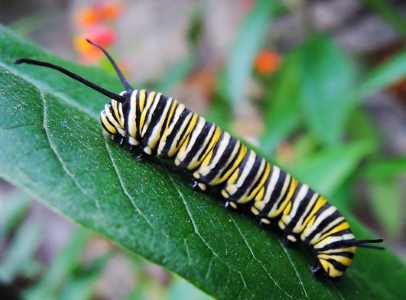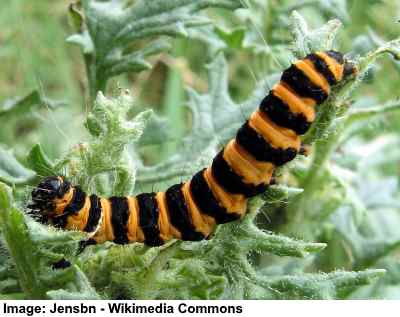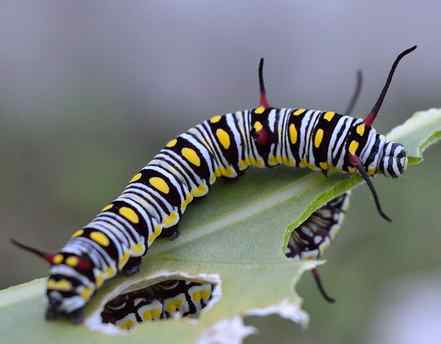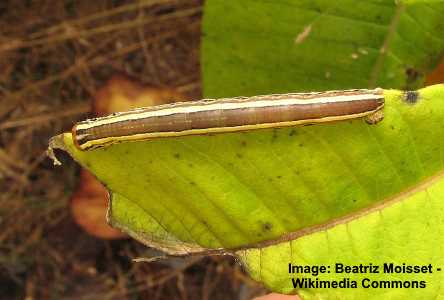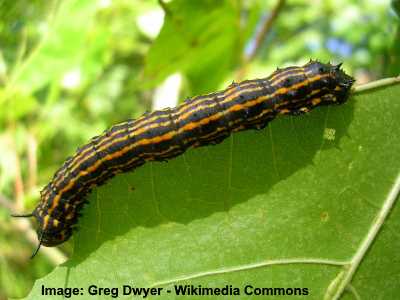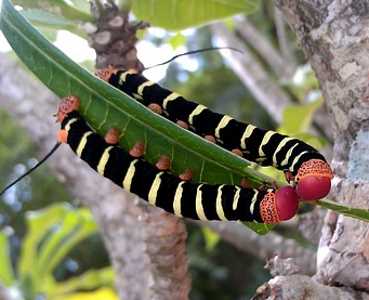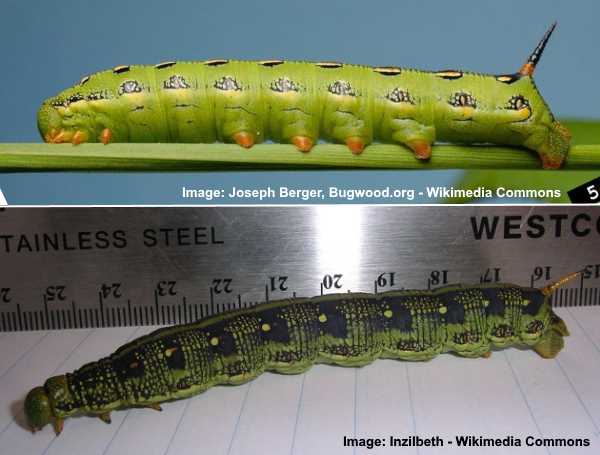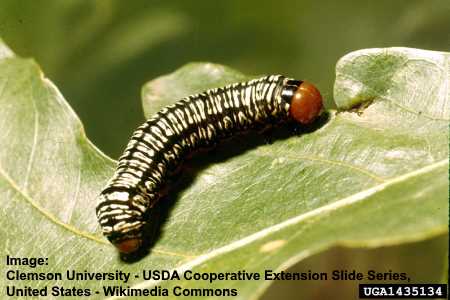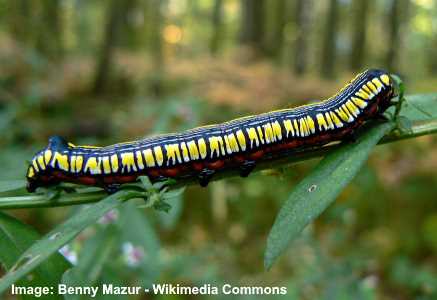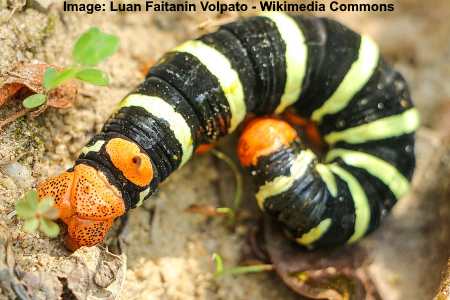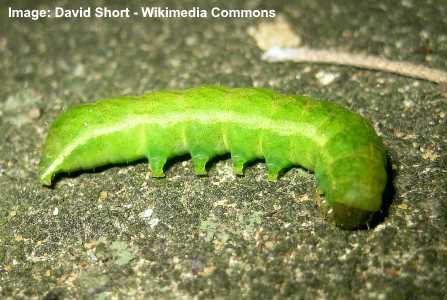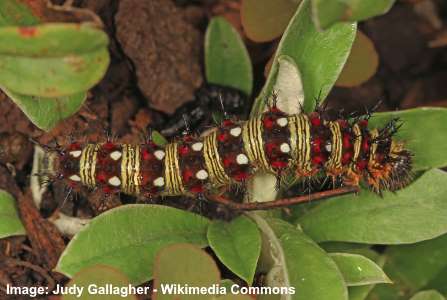37 Types of Striped Caterpillars with Pictures – Identification Guide
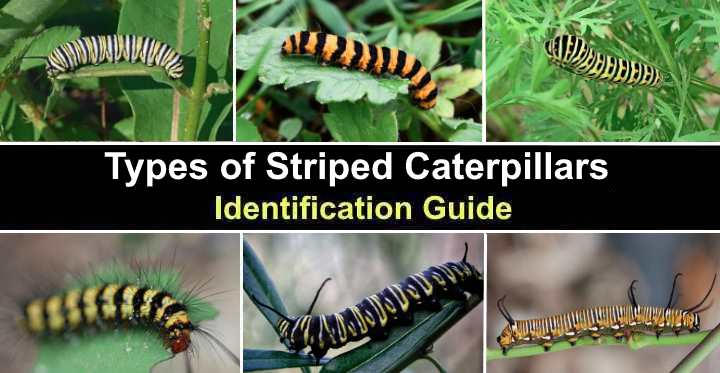
Caterpillars are larvae in the class Insecta that turn into beautiful moths or butterflies. Striped caterpillars are some of the most striking caterpillars you will find in your garden or in the wild. Different species of caterpillars with stripes can be identified by their vibrant colors, hairiness, number of spines, or size. Some of the most interesting striped caterpillars have black, white, and yellow stripes and long horns.
Striped caterpillars, just like all caterpillars, are a type of insect belonging to the order Lepidoptera. Caterpillars start their life as eggs before turning into larvae. They have a voracious appetite as they eat their way through plant and tree leaves. As the larvae mature, they go through a number of growth stages.
Depending on the caterpillar genus, they can also be classed as furry caterpillars and come in a range of colors. Some striped caterpillars are green with black and yellow stripes. Others can be black or green with white or yellow bands. Some fierce-looking spiky caterpillars can be black with orange stripes and dots.
Striped Caterpillar Identification
In order to identify striped caterpillars, it’s important to note their color, type of hairy covering, and specific markings. You should also note the specific colors of their stripes, spots or ‘horns’.
It is important to remember that immature caterpillars may look completely different from mature larvae. The descriptions and identifying features of striped caterpillars here are of mature larvae before they enter the pupation state.
Types of Striped Caterpillars (With Pictures and Names) – Identification Guide
Let’s look in more detail as some of the most fascinating types of striped caterpillars. Identifying the caterpillar characteristics will help to tell them apart. You will also find out which type of moth or butterfly these worm-like caterpillars turn into.
Monarch Butterfly Caterpillar (Danaus plexippus)
The Monarch caterpillar is a striped caterpillar in the family Nymphalidae and genus Danaus. This crawling insect feeds on milkweed as it goes through its growth stages.
Also called the ‘Common Tiger,’ ‘Wanderer,’ or ‘Milkweed’ caterpillar, this caterpillar species turns into one of the most beautiful and iconic butterflies, the Monarch.
The Monarch caterpillar has black, white, and yellow bands wrapping around its segments. As the striped caterpillar matures, a pair of horns grow at either end of its body. These are completely harmless and won’t sting you.
Another identifying feature of the Monarch caterpillar is the white dots on its prolegs. These are the stumpy ‘feet’ on the middle segments of the caterpillar’s body. Monarchs are a medium-sized species of caterpillar that can grow up to 2” (5 cm) long.
It is safe to handle these caterpillars as they don’t bite, aren’t poisonous, and don’t have stinging spines.
- Adult Stage: Monarch butterfly
- Host Plants: Mainly feeds on milkweed plants, including common milkweed, swamp milkweed, and others in the Asclepias genus
- Habitat and Distribution: Found in various habitats including fields, meadows, and gardens, primarily across North America, but also found in some parts of South America, Western Europe, and Australia
- Stinging: Monarch caterpillars do not sting or cause skin irritation
Black Swallowtail Caterpillar (Papilio polyxenes)
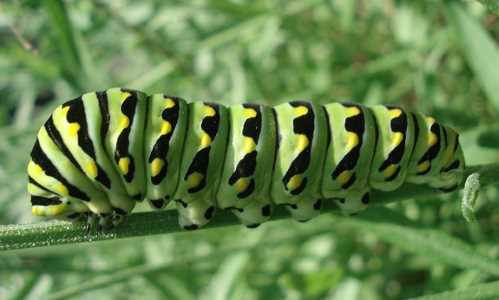
The Black Swallowtail Caterpillar can be identified by its black stripes and yellow markings on its green body
The Black Swallowtail butterfly caterpillar is a green species of caterpillar similar to the Monarch. This plump green caterpillar belongs to the Papilionidae family in the order Lepidoptera.
You can tell the Black Swallowtail apart from the Monarch caterpillar because it looks green, not black. Each green segment has a black stripe with yellow markings wrapping around its body. The 4 pairs of green prolegs also have black dots on them.
One of the interesting features of this long fat caterpillar is its osmeterium. This is a kind of forked-tongue that the caterpillar sticks out from behind its head. The caterpillar also releases a foul-smelling stench when predators threaten it.
This green caterpillar species loves to feed on the leaves of carrots, dill, parsley, and other garden herbs.
- Adult Stage: Black swallowtail butterfly
- Host Plants: Feeds on the leaves of various plants such as milkweed, including members of the carrot family (Apiaceae) such as parsley, dill, fennel, and Queen Anne’s lace
- Habitat and Distribution: Found in diverse habitats, including gardens, fields, meadows, and open areas, throughout North America
- Stinging: The black swallowtail caterpillar does not possess stinging capabilities or cause skin irritation
Cinnabar Moth Caterpillar (Tyria jacobaeae)
The Cinnabar caterpillar has wispy spines sticking out from an orange and black striped body. This caterpillar from the family Erebidae turns into the cinnabar moth which is a beautiful black and red variety.
These caterpillars are ravenous feeders. They can quickly decimate plants of their leaves and may even then start eating each other.
The striking black and orange caterpillar is easily identifiable due to its colored segments. Black bands wrap around a yellow or orange body and long thin grayish hairs stick out. Even though these caterpillars eat a lot of leaves, they only grow to about 1.2” (3 cm) long.
- Adult Stage: Cinnabar moth
- Host Plants: Feeds primarily on ragwort and groundsel, which are toxic to most animals but not to the cinnabar caterpillar
- Habitat and Distribution: Found in various habitats such as grasslands, meadows, and open areas, primarily in Europe, Asia, and some parts of North America
- Stinging: The cinnabar caterpillar does not possess stinging capabilities or cause skin irritation
Queen Caterpillar (Danaus gilippus)
Related to the Monarch butterfly, the larvae of the Queen butterfly looks like it has a white body with black stripes and yellow markings.
The Queen caterpillar is easy to recognize due to its unique combination of thin black stripes and wider black ones. It can be difficult to tell the Queen caterpillar and Monarch species apart. The Queen species has thicker black stripes that have yellow markings.
Another identifying characteristic of this black and white caterpillar are the pairs of long tentacles on its body. There is one pair at each end and a pair three-quarters along its length. Its head is black with white rings.
As the caterpillar matures, it becomes browner. Although black stripes are most common, species have been observed with yellow, green, blue, and dark brown stripes.
You can often find the Queen caterpillar in Southern states of the USA such as Texas, Florida and it is common in Mexico and Central America.
- Adult Stage: Queen butterfly
- Host Plants: Feeds on various species of milkweed, including Asclepias curassavica and other related plants
- Habitat and Distribution: Found in diverse habitats such as open areas, meadows, and gardens, primarily in North and South America
- Stinging: The queen butterfly caterpillar does not possess stinging capabilities or cause skin irritation
Striped Garden Caterpillar (Trichordestra legitima)
The Striped Garden caterpillar looks like a long brown worm with light stripes running the length of its body. These are one of the most commonly found garden caterpillars.
Apart from the long yellowish-white stripes, you can identify this caterpillar by its globular brown head. Striped Garden caterpillars mainly feed on herbaceous plants such as cherry, raspberry, mustard, milkweed, and violets.
- Adult Stage: Transforms into a moth
- Caterpillar Feeds on: Various plants, including tomatoes, cabbage, and other vegetables and crops
- Habitat: Found in gardens and agricultural fields; primarily found in North America
- Stinging: No, they do not have stinging hairs
Orange Striped Oakworm Caterpillar (Anisota senatoria)
As its name suggests, the orange striped oakworm is identified by a series of orange stripes running from head to tail. This horned caterpillar is completely harmless and won’t sting you.
This black and orange species grows to about 2.5” (5 cm) and constantly feeds on oak leaves. Its black body also features tiny spines that give the caterpillar a spiky appearance. Some species of orange-striped oakworms have pink or yellow stripes.
These caterpillars from the Saturniidae family turn into beautiful yellow, pink, and orange-colored moths.
- Adult Stage: Orange striped oakworm moth
- Host Plants: Feeds primarily on the foliage of oak trees, but also occasionally on hickory and other hardwood trees
- Habitat and Distribution: Found in deciduous forests and woodlands across the eastern United States and parts of Canada
- Stinging: The orange striped oakworm caterpillar does not possess stinging spines and is not known to cause skin irritation or stings
Giant Sphinx Caterpillar (Pseudosphinx tetrio)
The giant sphinx caterpillar is appropriately named due to its large size. This is one of the biggest striped caterpillars you are likely to come across as it can grow up to 6” (15 cm).
You can easily identify the giant sphinx due to the white or yellowish bands on its long fat black body. The head and tail ends are a brownish-orange or red color and there is a long protruding spike at the tail end. Another interesting feature of this stripy caterpillar is the 4 pairs of red-orange prolegs.
As you would expect from a striped caterpillar this size, it turns into a large moth with a wingspan of over 1 foot (30 cm)!
The Giant Sphinx is also a stinging species of caterpillar. Fine urticating hairs cover the caterpillar’s body and can cause skin irritation when handled. This is also one of the few caterpillar species that bite if caught.
- Adult Stage: Giant sphinx moth
- Host Plants: Feeds on various plants, including members of the Annonaceae family
- Habitat and Distribution: Found in tropical and subtropical regions of the Americas, particularly in Central and South America
- Stinging: The giant sphinx caterpillar, like other members of its species, is not stinging
White-Lined Sphinx Caterpillar (Hyles lineata)
The white-lined sphinx moth caterpillar is a green species of caterpillar with 2 white lines running up its side. There are many variations in color of these caterpillars from the Hyles genus.
The larvae of the white-lined sphinx moth have orange or black spots running in lines down the body. Some species can be a yellow color with black stripes. However, sometimes the caterpillar can be lime-green with lines of black dots and yellow stripes.
One of the identifying features of these caterpillars is the black-tipped orange or yellow horn at its tail end. Although this looks like a sharp spike, the protruding tail is completely harmless.
- Adult Stage: Develops into the white-lined sphinx moth
- Caterpillar Feeds on: Various plants, including members of the nightshade family (Solanaceae)
- Habitat: Found in a variety of habitats, including deserts, gardens, and open fields. Commonly seen in North and South America
- Stinging: Does not sting
Zebra Caterpillar (Melanchra picta)
As its name suggests, the Zebra caterpillar has black and white stripes crisscrossing its segments. This caterpillar species is also identified by yellow stripes running the length of the long body that can grow to 1.6” (4 cm) long.
You can often find Zebra caterpillars munching their way through cabbage leaves. These moth larvae start off white with black heads. As the caterpillars mature, they become more colorful. Black and bright yellow stripes line their body. There are white striped patterns giving some species a marbling effect.
To spot this leaf-hungry caterpillar, look out for a reddish-brown head with light-colored legs.
- Adult Stage: Develops into the American noctuid moth
- Caterpillar Feeds on: Consumes a variety of plants, including grasses and clover
- Habitat: Found in North America, often in grassy areas, meadows, and gardens
- Stinging: Zebra caterpillar larvae do not typically possess stinging spines
Brown Hooded Owlet Striped Caterpillar (Cucullia convexipennis)
Belonging to the family Noctuidae, the brown hooded owlet caterpillar looks similar to Zebra moth caterpillar. In fact, some people call this a zebra caterpillar.
There are a few ways to identify this caterpillar apart from the zebra caterpillar. There is a pronounced stump at one of its ends. A black stripe with faint white markings runs up its back. Along the sides are yellow stripes and a line of red dots.
You can often find the Brown Hooded Owlet caterpillar feeding on asters and goldenrods. After the pupation stage, the larvae turn into large gray moths.
- Adult Stage: Brown hooded owlet moth
- Host Plants: Feeds on a variety of plants including sunflowers, asters, and other members of the Asteraceae family
- Habitat and Distribution: Found in open grasslands, meadows, and agricultural areas across North America
- Stinging: The brown hooded owlet striped caterpillar does not possess stinging spines and is not known to cause skin irritation or stings
Azalea Caterpillar (Datana major)
Azalea caterpillars are unusual in that they have a large round head in relation to their green striped body. These hungry caterpillars feed in clusters and can quickly destroy azaleas as they feed on their leaves.
The coloring on Azalea caterpillars is pale green and yellow/orange. Wide black stripes and thinner green stripes run along its body. The caterpillar’s head is rusty brown or orange and oval and it has a smaller brownish tail. There are also spindly light hairs sprouting from its head.
Although these are not a dangerous type of caterpillar, an infestation can cause havoc in a garden. They feed on azaleas, rhododendrons, apples, and blueberries.
- Adult Stage: Azalea sphinx moth
- Host Plants: Feeds primarily on the foliage of azalea, and occasionally on other plants such as blueberries and Andromeda
- Habitat and Distribution: Found in gardens, forests, and shrublands, primarily in North America
- Stinging: The azalea caterpillar does not possess stinging capabilities or cause skin irritation
Angle Shades Moth Caterpillar (Phlogophora meticulosa)
The angle shades caterpillar is a smooth lime-green type of larvae with a pronounced pale stripe on each side.
Apart from the long stripe on each side of its back, there are faint yellowish dorsal lines separating the segments. Although green is the most common color of this species, there are also pinkish-brown types of larvae with similar stripes.
The green color of this striped moth caterpillar is excellent camouflage against green leaves.
- Adult Stage: Transforms into the angle shades moth
- Caterpillar Feeds on: Various herbaceous plants
- Habitat: Found in a wide range of habitats, including gardens and woodlands. Common and widely distributed in Europe
- Stinging: Does not sting
American Painted Lady Caterpillar (Vanessa virginiensis)
The American Painted Lady butterfly caterpillar is a stripy black fuzzy caterpillar with a number of horny spikes on it.
The stripes on the American Painted Lady are whitish or pale yellow bands on a dark brown body. These dorsal stripes separate each segment of this scary-looking caterpillar. The caterpillar is easily identified by the branched spines on its body. You will also notice red and white dots in between the white stripes.
- Adult Stage: American painted lady butterfly, a small butterfly with orange-brown wings and black spots
- Caterpillar Feeds on: Ironweed, asters, pussytoes, and other plants
- Habitat: Feeds on host plants in various habitats, including open areas and gardens; primarily found in North America
- Stinging: No, they do not have stinging hairs
Cross-Striped Cabbageworm (Evergestis rimosalis)
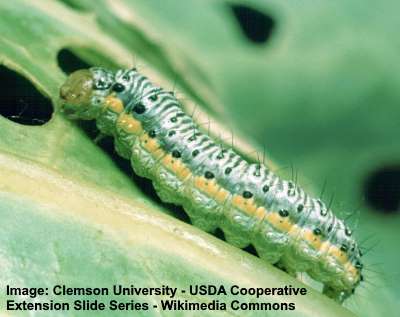
The Cross-Striped Cabbageworm has green body, white marks on the back and yellow stripe on each side
Although called a ‘worm,’ the cross-striped cabbage worm is a type of striped caterpillar with various colored markings. As its name suggests, these zebra-like caterpillars are stripy and eat cabbages.
The larvae of the cabbage worm belong to the family Crambidae and they turn into beautiful butterflies. These caterpillars generally have green bodies, green prolegs, and a green head. Yellow stripes run up their sides and they have rows of green and black dots. You will also notice eye-like markings on their backs.
Looking up close, you will also notice fine spines sticking out from its back. The best way to stop these pesky insects destroying your crops is to pick them off by hand. Their fine spines don’t sting and they are harmless caterpillars.
- Adult Stage: Develops into a small moth
- Caterpillar Feeds on: Various cruciferous plants, including cabbage and broccoli
- Habitat: Found in gardens and agricultural areas. Common in most of the eastern United States
- Stinging: Does not sting
Angus Datana Moth Caterpillar (Datana angusii)

The Angus Datana Caterpillar is a black and yellow/white striped caterpillar with fuzzy hair
Native to North America, the Angus datana caterpillar is a type of striped furry caterpillar. Although this isn’t as fuzzy as a woolly bear, it has long spindly spines all over its body.
The main identifying feature of these fuzzy caterpillars are the black and white or yellow stripes running the length of its body. Clusters of whitish-gray wispy hairs grow from each segment. One identifying aspect of this long black caterpillar is its black oval head.
- Adult Stage: Angus datana moth
- Host Plants: Feeds on the foliage of various trees including oaks, hickories, and maples
- Habitat and Distribution: Found in deciduous forests and woodlands across the eastern United States and parts of Canada
- Stinging: The Angus datana moth Caterpillar does not possess stinging spines and is not known to cause skin irritation or stings
Gulf Fritillary Caterpillar (Agraulis vanillae)
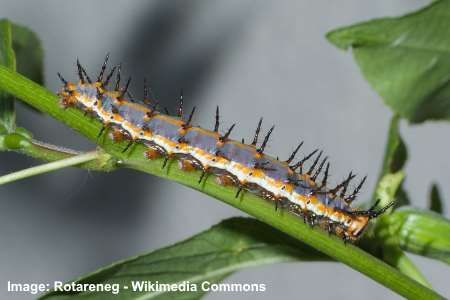
The Gulf Fritillary Caterpillar has gray or brown spiky body with white and yellow stripes along its sides
One colorful example of a stripy spiky caterpillar is the Gulf Fritillary caterpillar. These brightly colored caterpillars are found in regions in Texas and Florida.
Jaggy looking black spines stick out from its back and sides. The caterpillar has a dark brown or gray back that has an orange/yellow stripe on either side. Along its sides runs a single white stripe.
You can expect to find this species of caterpillar munching away on plants in the Passiflora group. This caterpillar transforms into a butterfly which is just as colorful.
- Adult Stage: Gulf fritillary butterfly
- Host Plants: Passionflowers (Passiflora species) are the primary host plants for this caterpillar
- Habitat and Distribution: Found in the southern United States, Central and South America, and as far south as Argentina
- Stinging: The gulf fritillary caterpillar does not sting
Rosy Maple Caterpillar (Dryocampa rubicunda)
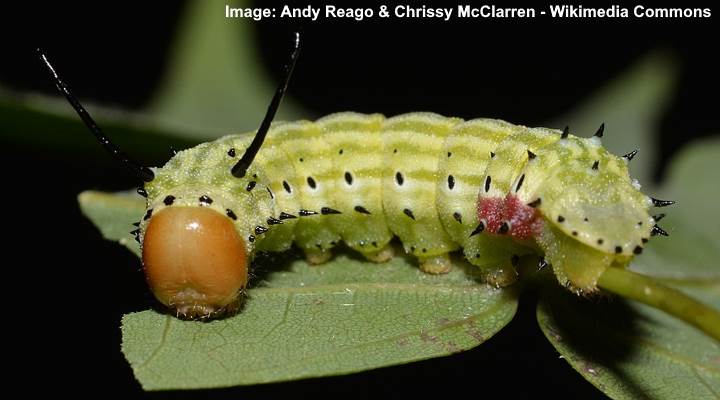
The rosy maple caterpillar has light green and white stripes with black dots
The Rosy Maple caterpillar is a large plump caterpillar with light green and white stripes. In some ways, the striped markings can resemble hard-boiled candies.
This species of caterpillar is easy to identify due to the stripy pattern running down its length. The back has wider white stripes with thin green ones and the sides have wider green stripes. Another feature of this caterpillar is the small black dots on the sides of each of its segments.
You can also tell this caterpillar apart from others by its orange-reddish head and the red markings on its tail end. There are also 2 black horns poking out from its head and small black spikes on its rear end and prolegs.
After the pupation stage, the larvae emerge as some of the most beautiful moths in North America. The moth’s body and wings are shades of pinks and orange.
- Adult Stage: Transforms into the rosy maple moth
- Caterpillar Feeds on: Maple tree leaves, particularly those of the red maple
- Habitat: Found in woodlands and gardens where maple trees grow. Commonly seen in parts of North America
- Stinging: Does not sting
Tobacco Hornworm Caterpillar (Manduca sexta)
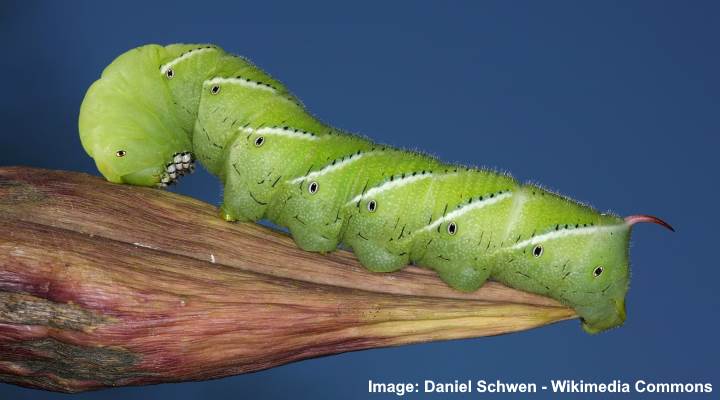
The large tobacco hornworm caterpillar has diagonal white stripes along the sides of its body
The tobacco hornworm is a large green caterpillar with white diagonal stripes along its sides. Similar to the tomato hornworm, this striped caterpillar has a plump lime-green body with a conspicuous pinkish horned tail. Also, the side of each segment has a white-ringed dark eyespot.
The tobacco hornworm caterpillar can grow up to 4” (100 mm) long. Although this harmless green caterpillar won’t bite or harm you, it can cause damage to plants. You will often find the destructive pest on tomato and tobacco plants.
The main difference between the tobacco and tomato hornworm (Manduca quinquemaculata) is its striped markings. The tomato hornworm has V-shaped markings, whereas the tobacco hornworm has slanted markings.
- Adult Stage: Tobacco hawk moth
- Host Plants: Feeds primarily on the leaves of plants in the nightshade family, including tobacco plants, tomato plants, and other related species
- Habitat and Distribution: Found in various habitats such as gardens, agricultural fields, and open areas, primarily across North and South America
- Stinging: The tobacco hornworm caterpillar does not possess stinging capabilities or cause skin irritation
Stinging Rose Caterpillar (Parasa indetermina)
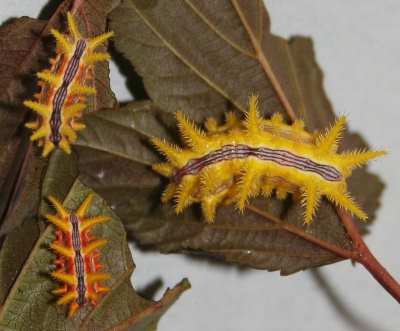
The stinging rose caterpillar has a striped back and clusters of toxic spikes along its body
The stinging rose larva is an unusual striped caterpillar with a purple band along its back and jagged spiny projections. The strange-looking caterpillar has a flattened body that is dark orange or vivid yellow. As its name suggests, this striped, yellow caterpillar has venom-filled spines that cause a nasty sting.
The stinging rose moth caterpillar measures 1” (25 mm) long. However, the venomous spines along its back and flattened shape make it appear larger. When handled, the urticating fluid in the spines causes a painful sting that can last for days.
You will find this venomous striped caterpillar along the East Coast of the US, from New York to Florida and east to Texas.
- Adult Stage: Stinging rose caterpillar moth
- Host Plants: Feeds on a variety of plants including rose bushes, hibiscus, and other ornamental plants
- Habitat and Distribution: Found in gardens, parks, and forested areas, primarily in North America
- Stinging: The stinging rose caterpillar possesses spines that can cause skin irritation and mild stinging if touched
White-Marked Tussock Caterpillar (Orgyia leucostigma)
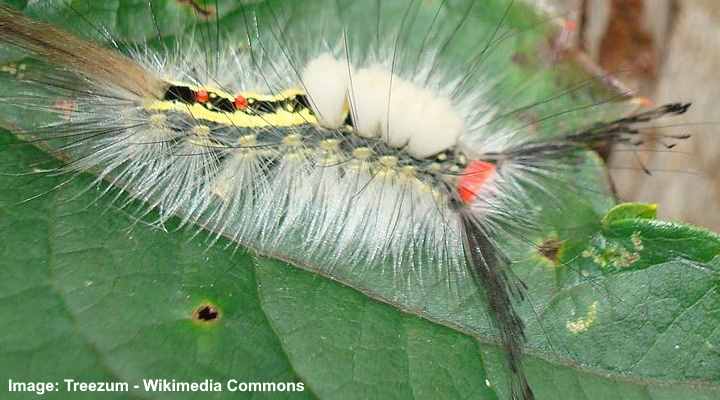
The white-marked tussock caterpillar is easily identified by its black and yellow stripes and unique hairy look
The white-marked tussock caterpillar is recognizable by its hairy appearance and bright yellow and black stripes on its body. In addition, the strange-looking caterpillar has four cream-colored bristly tufts and is covered in long whisker-like spines. You will also notice other identifiable features like bright red dots on its back and black pencil hairs at its hind end.
The white-marked tussock caterpillar grows up to 1.3” (35 mm) long, excluding the length of its wispy hairs. Although it isn’t a stinging striped caterpillar, the fine hairs have barbed ends that can stick in the skin, causing an itching sensation.
You will find the exotic-looking caterpillars skeletonizing foliage on deciduous and coniferous trees throughout North America.
- Adult Stage: Transforms into the white-marked tussock moth
- Caterpillar Feeds on: Feeds on the leaves of various trees and shrubs
- Habitat: Native to North America, often in forests, woodlands, and urban areas
- Stinging: White-marked tussock moth caterpillars possess mildly irritating spines but do not deliver severe stings
Pink-Striped Oakworm Moth Caterpillar (Anisota virginiensis)

The pink-striped oakworm moth caterpillar is covered with tiny white dots and has two antennae-like horns
The pink striped oakworm moth larva is a dark-colored, white spotted caterpillar with pink stripes. Pictures of the striped caterpillar show it has small fleshy projections on its body, a rounded, flat olive-colored face, and a pair of antennae-like horns. It also has four pairs of black prolegs.
The pink-striped oakworm moth caterpillar grows up to 2” (50 mm) long and has a cylindrical body. The spiny, striped caterpillar also has color variations of a greenish body with dull brownish yellow stripes.
This leaf-feeding caterpillar has a voracious appetite and feeds on leaves on maple, oak, birch, and hazel trees.
- Adult Stage: Pink-striped oakworm moth
- Host Plants: Feeds primarily on the foliage of oak trees, but also occasionally on hickory and other hardwood trees
- Habitat and Distribution: Found in deciduous forests and woodlands across the eastern United States and parts of Canada
- Stinging: The pink-striped oakworm moth materpillar does not possess stinging spines and is not known to cause skin irritation or stings
Giant Woolly Bear Caterpillar (Hypercompe scribonia)
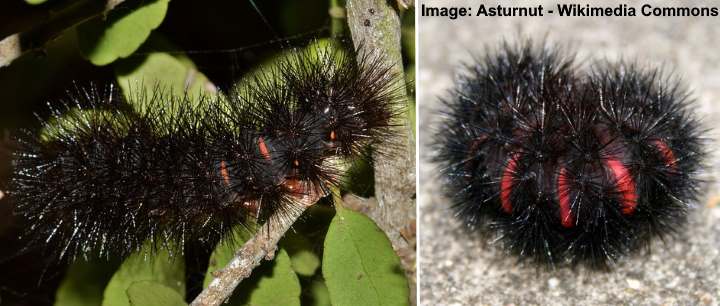
The giant woolly bear is black spiky caterpillar that also has red stripes between its black segments
The giant woolly bear caterpillar is described as a hairy black caterpillar with red stripes. The black fuzzy caterpillar’s red stripes are seen when it curls into a defensive position. Despite its furry appearance, the black caterpillar’s spines are relatively sharp and can irritate your skin when handled.
The red-striped hairy black caterpillar grows up to 3” (75 mm) when mature. When the woolly bear caterpillar is immature, it is a black caterpillar with orange stripes and a sparse covering of black tufts. You’ll find the large black and red striped caterpillar on citrus trees, cabbage plants, sunflowers, and willow trees.
This striped black and red caterpillar is poisonous to birds and predators.
- Adult Stage: The giant woolly bear caterpillar transforms into a beautiful moth known as the giant leopard moth. The adult moth is striking, with its black-and-white spotted pattern on its wings
- Host Plants: The giant woolly bear caterpillar feeds on a variety of plants, including dandelions, clover, violets, and other herbaceous vegetation
- Habitat and Distribution: These caterpillars are commonly found in gardens, fields, meadows, and woodlands throughout North America
- Stinging: The giant woolly bear caterpillar is not known to sting or cause skin irritation
Hackberry Emperor Caterpillar (Asterocampa celtis)
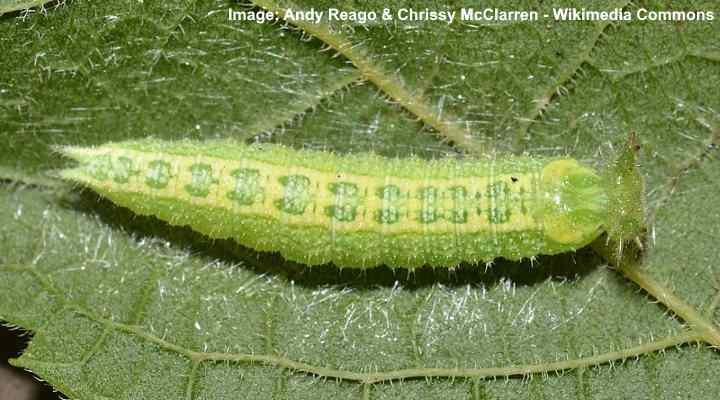
The hackberry emperor caterpillar is pale green with yellowish stripe along its body and a split tail at its rear
The hackberry emperor butterfly larva is a slug-like green caterpillar with two thin yellow stripes running the length of its pale green body. The pattern on the yellow stripes can appear as a single yellow band with kidney-shaped green patterns. The sizable striped caterpillar has a distinctive forked tail end.
The hackberry emperor caterpillar grows around 1.5” (40 mm) long. The green and yellow caterpillar can be challenging to spot on trees because it blends into the foliage. Other identifying features are a flattened translucent green head and tiny yellow raised dots covering its body.
- Adult Stage: Develops into the hackberry emperor butterfly
- Caterpillar Feeds on: Various host plants, including hackberry (Celtis species)
- Habitat: Found in parts of North America in a range of habitats, including woodlands and open areas where hackberry trees grow
- Stinging: Does not sting
Dragon-Headed Caterpillar (Polyura athamas)
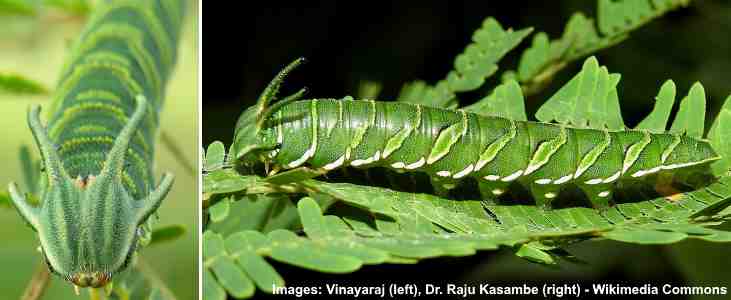
The green dragon-headed caterpillar has 4 horns on its head and green or yellow stripes on its sides
The dragon-headed caterpillar is a green caterpillar with yellow-green stripes along its body and a row of white spots. Depending on the instar, the stripes can appear dark green traversing the slug-shaped green caterpillar. The characteristic features of the caterpillar are its four spiny horns emerging from a shield-shaped, flat face.
The green and yellow striped dragon-headed caterpillar grows up to 1.18” (30 mm) before pupation. When mature, the caterpillar is dark green with three yellow V-shapes on its back.
This large dark green caterpillar is a nocturnal feeder. You will find it chewing through the foliage of various types of plants
- Adult Stage: Develops into the dragon-headed butterfly
- Caterpillar Feeds on: Leaves of various plants in the bean family (Fabaceae)
- Habitat: found in parts of Asia in woodlands and open areas
- Stinging: Does not sting
Banded Sphinx Caterpillar (Eumorpha fasciatus)
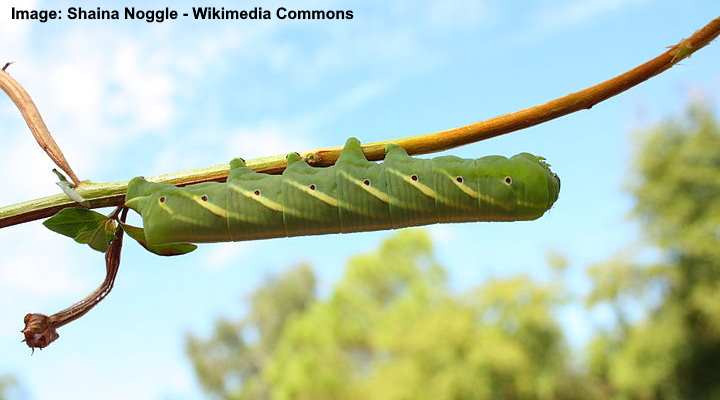
The large banded sphinx caterpillar is green with yellow diagonal lines and black dots but can have color variations
The larva from the banded sphinx moth is a large, cylindrical-shaped green caterpillar with slanted yellow stripes on its sides. The banded sphinx moth caterpillar grows up to 3” (76 mm) long and has a distinctive slug-shaped appearance. However, there are tremendous color variations with this striped caterpillar.
Some caterpillars are green with black traversing stripes and white diagonal bands. In contrast, other multicolored variations are rusty brown with yellow stripes. And as the caterpillar matures to pupation, some species become bright red with yellow stripes. Additionally, the caterpillar has a distinctive tail horn during the third instar.
- Adult Stage: Transforms into a sphinx moth within the Eumorpha genus
- Caterpillar Feeds on: Leaves of various plants, including grapevines
- Habitat: Found in gardens, woodlands, and vineyards. Common in parts of South America, Central America, and parts of USA
- Stinging: Does not sting
Honey Locust Moth Caterpillar (Syssphinx bicolor)
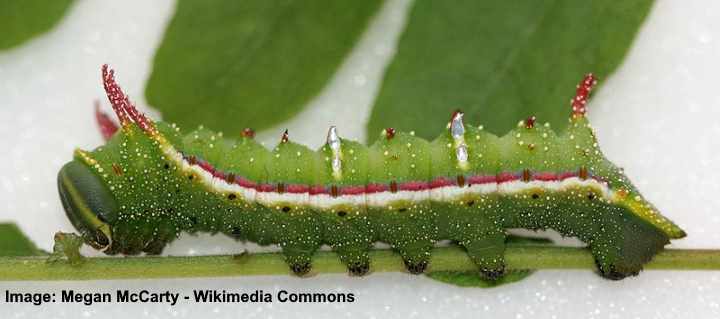
The honey locust caterpillar is identified by its green body with white dots, red and white line along its sides and two red horns
The larva from the honey locust moth is a strange green striped caterpillar with red horn projections at either end, white speckles, and pointed short silvery fleshy spines on each segment. The stripe on this green caterpillar is a red and white band running along the sides of its abdomen.
The honey locust caterpillar grows 1.5” (38 mm) long and has a stout green body with a red and white stripe along its side before pupation. However, during its second instar, the green caterpillar has a white and black line along its body and several black spiny horned protections at its head.
- Adult Stage: Develops into the honey locust moth
- Caterpillar Feeds on: Leaves of honey locust trees
- Habitat: Found in woodlands and areas with honey locust trees in North America
- Stinging: Does not sting
Orange-Barred Sulphur Caterpillar (Phoebis philea)
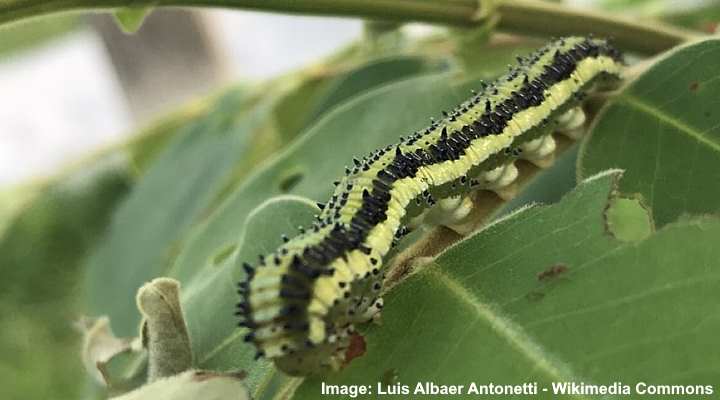
The pale green and black striped orange-barred sulphur caterpillar has small black bumps along its body
The orange-barred sulphur larva is a green, yellow, and black striped caterpillar covered in tiny bluish-black fleshy bumps. The yellowish-green caterpillar has yellow prolegs and a dark green head. However, as the slug-shaped caterpillars mature, they become more yellow, with black bands traversing each segment.
After pupating, the yellow-green striped caterpillar becomes a stunning yellow butterfly, common throughout North America.
- Adult Stage: Develops into the orange-barred sulphur butterfly
- Caterpillar Feeds on: Leaves of plants in the legume family (Fabaceae)
- Habitat: Commonly seen in parts of the Americas in various open habitats, including gardens and fields.
- Stinging: Does not sting
Box Tree Moth Caterpillar (Cydalima perspectalis)
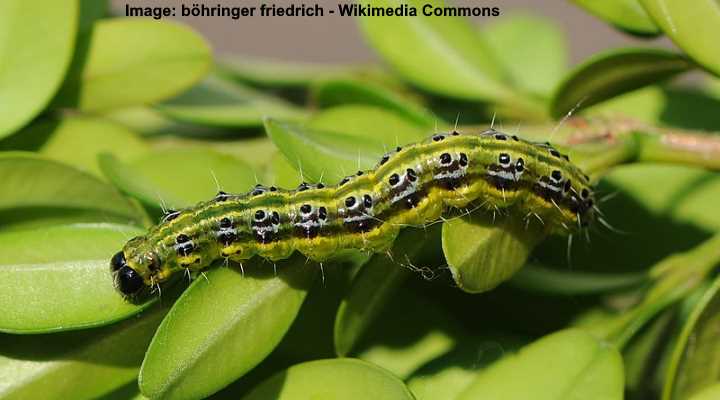
The box tree caterpillar has a green, black and yellow striped body with black spots and fine hairs
The larva of the box tree moth is described as a green striped caterpillar with bands of black and yellow running longitudinally. The other identifiable features of this black, yellow, and green caterpillar are its round black head, fine white spines, and pairs of black bumps in two rows on its back.
The green and black striped box tree moth caterpillar grows 1.5” (40 mm) long. It gets its common name because the caterpillar is often found on boxwood shrubs (Buxus spp.). If not controlled, these stripy green caterpillars can defoliate entire shrubs.
- Adult Stage: Develops into the box tree moth
- Caterpillar Feeds on: Leaves of boxwood (Buxus) plants
- Habitat: Found in gardens and areas with boxwood cultivation. Considered invasive and spreading in parts of Europe
- Stinging: Does not sting
Hieroglyphic Moth Caterpillar (Diphthera festiva)
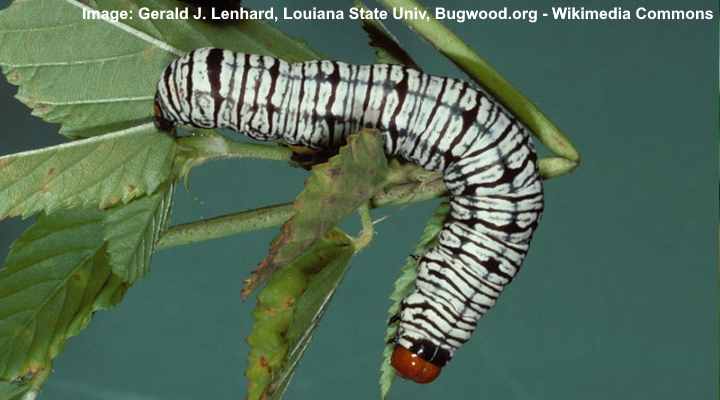
The hieroglyphic caterpillar has a white smooth body with black and gray stripes and reddish head
The hieroglyphic moth larva is a white caterpillar with black stripes. This eye-catching slug-like caterpillar has bands of black and white zebra markings around its body. In addition, the caterpillar also has a rusty, red-colored head and white and black legs. Its bright coloring makes this striped caterpillar easy to spot.
The hieroglyphic moth caterpillar grows 1.77” (45 mm) long. The black and white caterpillar is common throughout Florida, where it feeds on sweet potato, soybean, and pecan crops. Heavy infestations can cause severe damage to plants.
- Adult Stage: The adult hieroglyphic moth is a large, brown moth with intricate markings
- Caterpillar Feeds on: The caterpillar feeds on the leaves of various hardwood trees
- Habitat: These caterpillars can be found primarily in North America in woodlands and gardens
- Stinging: No, they do not have stinging hairs
Pink-Spotted Hawkmoth Caterpillar (Agrius cingulata)

The large pink-spotted hawkmoth caterpillar has dark brown body with orange lines and creamy patterns and pointed tail
The pink spotted hawkmoth larva is best described as a large black or dark brown caterpillar with pinkish or orange-brown stripes. This dark, striped caterpillar has conspicuous eyespot markings along its sides set in a broad pale creamy-pink band. In addition, two thin darker orange-pink bands go along its back.
The sizable black or dark brown striped caterpillar grows up to 3.14” (80 mm) long. Its dark smooth body, dusty orange stripes, and huge size make it easy to identify in landscapes. It is often found defoliating sweet potato plants.
- Adult Stage: Pink-spotted hawkmoth, a large, brown moth with pink spots
- Caterpillar Feeds on: Sweet potato, morning glory, and jimson weed leaves
- Habitat: Found throughout the United States where host plants grow
- Stinging: No, they do not have stinging hairs
Yellownecked caterpillar (Datana ministra)
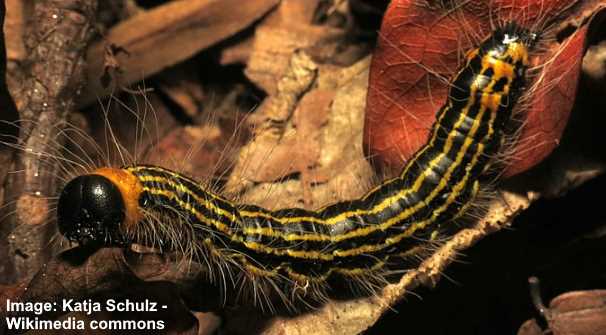
Yellownecked caterpillar has black and yellow bands along its hairy body
One of the most striking black caterpillars with yellow stripes is the yellownecked caterpillar. The black and yellow striped larva has a distinctive black head with a pronounced orange or yellow collar-like growth. In addition, long wispy hairs sparsely cover the cylindrical caterpillar, giving it a fuzzy appearance.
These large black and yellow striped caterpillars grow 2” (50 mm) long. The long, slender caterpillars have an identifying defensive habit, creating a “U” shape by curling their head back. Some pictures of this striped hairy caterpillar show it has brown and yellow stripes.
- Adult Stage: Transforms into the yellownecked caterpillar moth
- Caterpillar Feeds on: Consumes the leaves of deciduous trees, including hickory and walnut
- Habitat: Common in North America, often in forests and woodlands
- Stinging: Yellownecked caterpillar larvae may have mildly irritating spines but are not known for severe stings
Yellow-Tail Moth Caterpillar (Sphrageidus similis or Euproctis similis)
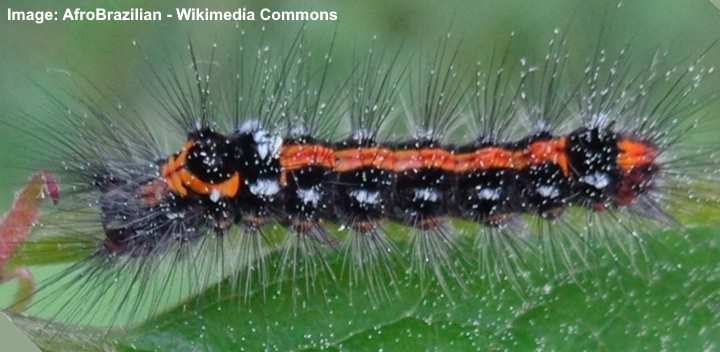
The hairy yellow-tail moth caterpillar is identified by its black body with orange lines on its back and white spots on the sides
The yellow-tail moth larva is an orange and black striped caterpillar covered in tufts of long fine hairs. The eye-catching black and orange caterpillar has a distinctive row of white spots along its sides. These contrast with the vivid reddish-orange band on its black body and the reddish bumps at its head.
The black caterpillar with its orange stripe measures 1.2” (30 mm) long. You will typically find the leaf-eating larvae chewing through leaves on oak, birch, rowan, and alder trees, along with various fruit trees.
- Adult Stage: Yellow-tail moth
- Host Plants: Feeds on a variety of trees including oak, willow, and maple
- Habitat and Distribution: Found in various regions of North America, particularly in forested areas and urban settings.
- Stinging: The yellow-tail moth caterpillar is covered in fine hairs that may cause skin irritation; however, it does not sting
Eight-Spotted Forester Caterpillar (Alypia octomaculata)
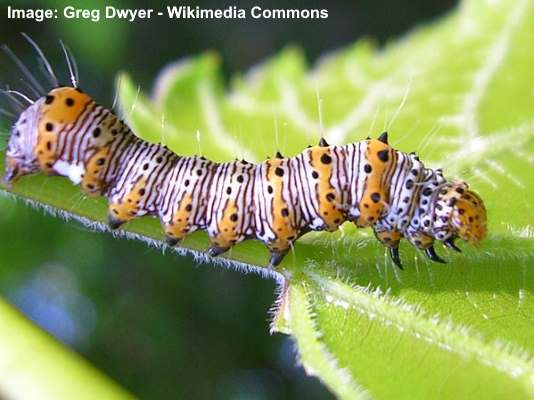
The eight-spotted forester caterpillar has black, white and orange stripes with black hairy bumps
The brightly colored eight-spotted forester caterpillar is orange with thin white and black bands traversing its segments. Along with the colorful stripes, this caterpillar has small black pointed fleshy bumps, giving the larva a striped and spotted appearance. You’ll also notice wispy white hairs poking out from its body.
The orange caterpillar with its black dots and black and white stripes grows up to 1.30” (33 mm) when mature. These orange and black striped caterpillars are common throughout the eastern part of North America, where they feed on Virginia creeper plants.
- Adult Stage: Eight-spotted forester moth
- Host Plants: Various plants including grapevine, Virginia creeper, and peppervine.
- Habitat and Distribution: Woodlands, gardens, and open areas throughout the eastern United States and southeastern Canada.
- Stinging: The eight-spotted forester saterpillar is not known to sting or cause skin irritation
Catalpa Sphinx Caterpillar (Ceratomia catalpae)
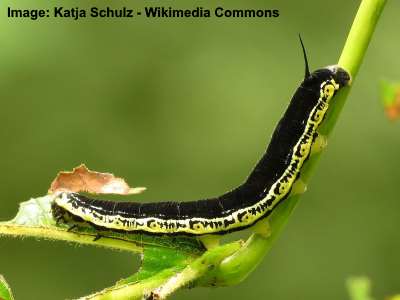
A mature catalpa sphinx caterpillar has a black body with yellow stripe along each side
The catalpa sphinx larva is one of the most striking black caterpillars with yellow stripes. Also called the Catawba worm, the long worm-like caterpillar becomes jet black with a neon yellow band along its sides. The yellow and black caterpillar is also identified by its pronounced black horn-like tail.
The slender black caterpillar with the yellow stripes measures 2” (50 mm). Like identifying different caterpillar species, the catalpa sphinx has color variations through various instars. For example, immature caterpillars are greenish yellow with a black stripe down their back.
- Adult Stage: The adult form of this caterpillar is the Catalpa sphinx moth
- Host Plants: Catalpa sphinx caterpillars feed on the leaves of catalpa trees (Catalpa species)
- Habitat and Distribution: They are commonly found in regions where catalpa trees grow, including parts of North America
- Stinging: Catalpa sphinx caterpillars do not sting or cause skin irritation
Redhumped Caterpillar (Schizura concinna)
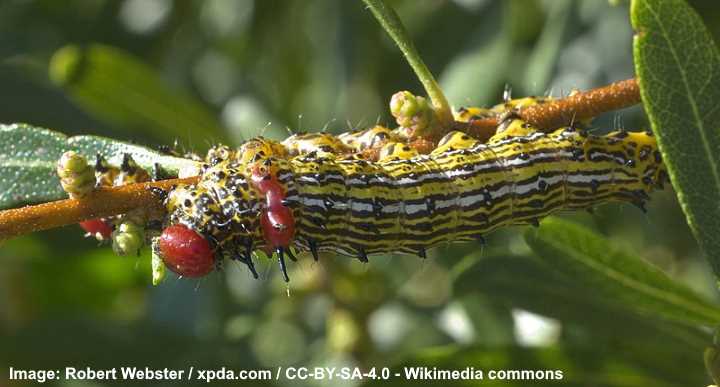
The attractive-looking redhumped caterpillar has yellow, black and white striped body with red head
The larva of the redhumped moth is a yellowish, striped caterpillar with lateral white, black, and yellow stripes. Other identifying features of the stripy caterpillar are its bulbous red head, reddish growths behind its head, and short black fleshy spines. In addition, the older caterpillars have an identifiable trait of keeping their rear end raised.
The redhumped caterpillar grows 1” to 1.5” (25 – 38 mm) long. Through its growth stages, the caterpillar retains its yellow color with black and white stripes. The native habitat of this black-striped yellow caterpillar is throughout North America, feeding on woody plants.
- Adult Stage: Redhumped moth
- Host Plants: Fruit trees, walnut trees, cottonwood trees, and willow trees
- Habitat and Distribution: Deciduous forests and woodlands across North America
- Stinging: This caterpillar does not sting, although some individuals might be sensitive to its tiny spines, causing mild irritation
Old World Swallowtail Caterpillar (Papilio machaon)
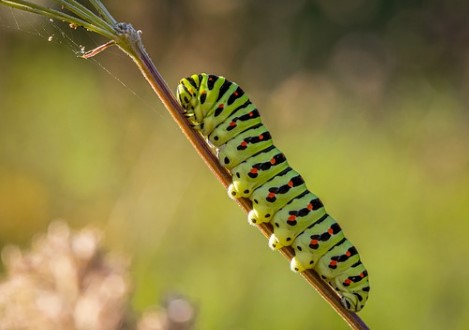
The colorful old world swallowtail caterpillar has green body, black stripes and orange dots
The old world swallowtail butterfly larva is a lime green caterpillar with red- or orange-spotted black stripes wrapping around each segment. The large, plump green caterpillar also has a line of black dots along the base of its abdomen and a few yellow spots near its head.
The green, black, and orange striped old world swallowtail caterpillar measures 1.8” (45 mm) long. This caterpillar’s defensive habit is raising its body, producing fleshy projections from behind its head, and releasing a foul-smelling chemical.
- Adult Stage: Old world swallowtail butterfly
- Host Plants: Feeds on a variety of plants in the carrot family, including parsley, dill, and fennel
- Habitat and Distribution: Found in meadows, gardens, and open spaces across Europe and Asia
- Stinging: The old world swallowtail caterpillar is not stinging
Common Buckeye Caterpillar (Junonia coenia)
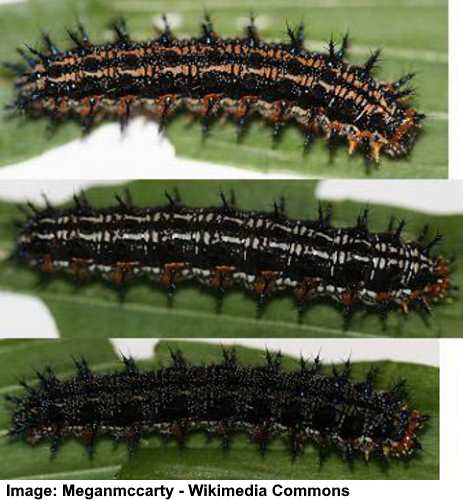
The black and brown common buckeye caterpillar has some color variations
The common buckeye butterfly larva is a spiky black caterpillar with orange-brown or white stripes along its back. The striped caterpillar has distinctive features like a reddish-orange head with black markings, orangey-brown spots, and a brown underside. The spiny black caterpillars grow 1.5” (40 mm) long.
Common buckeye caterpillars have several variations in appearance. Some are black caterpillars covered in branched spines and tiny white dots. Others are black caterpillars with white stripes.
Buckeye caterpillars adapt well to hot, dry climates and are common in Arizona and other desert states.
- Adult Stage: The adult stage is commonly known as the buckeye butterfly
- Host Plants: Its caterpillars feed on various plants, including those from the snapdragon family (Scrophulariaceae) and plants from the Acanthaceae family
- Habitat and Distribution: The Junonia coenia caterpillar can be found in open areas, gardens, roadsides, and meadows throughout North and South America
- Stinging: There are no reported instances of the Junonia coenia caterpillar causing skin irritation or stinging
Frequently Asked Questions about Striped Caterpillars
Are striped caterpillars poisonous?
Caterpillars with stripes are generally harmless and won’t sting you. Usually, fuzzy caterpillars are the dangerous type as they have urticating hairs that contain toxins. These can break off in your skin and cause irritation, hives, and swelling.
What do striped caterpillars feed on?
Striped caterpillars feed on leaves of plants and trees. Some stripy caterpillar species such as the Monarch caterpillar feeds exclusively on milkweed. Other species of striped caterpillar feed on various other plant matter. There are also some types of striped caterpillars that eat other insects or even other caterpillars.
Related articles:

